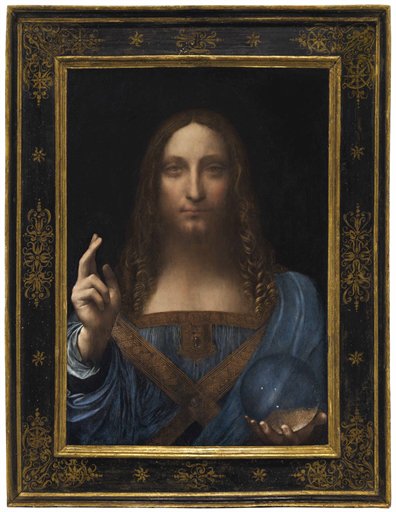How do you know we are living through the biggest bubble in history? Simple: when a painting, doesn't matter who the artist is, doesn't matter who rare and prized, sells for half a billion dollars.
A rediscovered painting by Leonardo da Vinci broke the record price for art at an auction on Wednesday night, selling for just over $450 million (or a bargain basement 62,500 bitcoin to the Chinese money launderer who bought it) at Christie’s in New York. The last da Vinci in private hands sold nearly 4 times above its estimated price after a fevered, 90-minute long round of bidding. It is widely believed to be the most expensive piece of art ever sold.
The 500-year-old “Christ as Salvator Mundi,” which was originally estimated at $100 million, was the star of Christie’s evening sale of postwar and contemporary art, what Bloomberg described an unconventional move by the auction house because of its vintage. The previous auction record for an Old Master painting was held by Peter Paul Rubens, whose “The Massacre of the Innocents” fetched $76.5 million in 2002.
“Salvator Mundi,” Latin for Saviour of the World, was one of only 15 surviving works by Leonardo da Vinci and depicts Jesus Christ in a flowing robe, holding a crystal orb and raising his right hand in benediction.
The 67.5cm tall portrait, which once belonged to England’s King Charles I in the 17th century, disappeared around 1900. In 2005, it was bought at an estate sale and, after six years of research and restoration, attributed to da Vinci, the first such rediscovery in more than 100 years. Before the auction, Christie’s secured an irrevocable $100 million bid by an anonymous investor meaning it was sure to sell.
The painting, called "Salvator Mundi," Italian for "Savior of the World," is one of fewer than 20 paintings by Leonardo known to exist and the only one in private hands. It was being sold by Russian billionaire Dmitry Rybolovlev’s family trust. The fertilizer king purchased it for $127.5 million in 2013 and it’s been at the heart of an international legal battle. Rybolovlev assembled a $2 billion trove with the help of art entrepreneur Yves Bouvier, but in recent years has been selling off works from the collection, often at steep discounts.
Well, even he will be happy with the 250% return in just 4 years. Also happy will be Christies: the $450 price also includes $50.3 million in premiums paid to Christie’s for its services by the buyer.
Jussi Pylkkanen, auctioneer for the evening, opened bidding on the piece at $70m and offers rapidly vaulted higher, according to the FT. Gasps broke out throughout the salesroom in Rockefeller Centre when an offer hit $200m. Bidders interested in the Da Vinci — lot 9 of the evening’s sale — were given special red paddles in the salesroom, a move the auction house attributed to the work’s high worth, although much of the action was fuelled by phone bidders.
Some more details on the painting's troubled recent history:
Following its rediscovery and sale in 2013, the painting was at the centre of a legal feud between current owner Dmitry Rybolovlev, the Russian billionaire and owner of AS Monaco football club, and Yves Bouvier, the owner of Natural Le Coultre, one of the largest fine art storage and shipping specialists.
The protracted legal battle centred around claims that Mr Bouvier allegedly bought the painting for $80m and sold it to Mr Rybolovlev for $127.5m, a near $50m difference. A small group of critics have even questioned the painting’s authenticity.
After its original disappearance, the painting was acquired in 2005, badly damaged and partly painted-over, by a consortium of art dealers who paid less than $10,000 (8,445 euros). The art dealers restored the painting and documented its authenticity as a work by Leonardo.
Christie's says most scholars agree that the painting is by Leonardo, though some critics have questioned the attribution and some say the extensive restoration muddies the work's authorship. Christie's capitalized on the public's interest in Leonardo, considered one of the greatest artists of all time, with a media campaign that labeled the painting "The Last Da Vinci." The work was exhibited in Hong Kong, San Francisco, London and New York before the sale.
Other paintings on offer on Wednesday evening included works by Mark Rothko, Jean-Michel Basquiat, Keith Haring, Cy Twombly, and Andy Warhol. Christie’s said it was in part the inclusion of the 32ft Warhol painting Sixty Last Suppers, which riffed on Da Vinci’s famed The Last Supper, that the house attempted to secure ‘Salvator Mundi’ for auction. ‘Sixty Last Suppers’ features a black-and-white silkscreen grid of 60 prints of ‘The Last Supper’ and was among the last works created by Mr Warhol before his death in 1987.
And just to confirm that everything around you is indeed one giant bubble, the exquisite piece of modernist "art" you see below, sold for more than $46 million.
Credit to ZeroHedge.com

 Volunteers pick olives in Samaria for Temple oil. (Courtesy of Sanhedrin)
Volunteers pick olives in Samaria for Temple oil. (Courtesy of Sanhedrin) (Courtesy of Sanhedrin)
(Courtesy of Sanhedrin) Israeli children press olives for Temple oil. (Courtesy Sanhedrin)
Israeli children press olives for Temple oil. (Courtesy Sanhedrin) Wearing masks and gloves, volunteers crush olives for ritual oil. (Courtesy Sanhedrin)
Wearing masks and gloves, volunteers crush olives for ritual oil. (Courtesy Sanhedrin)